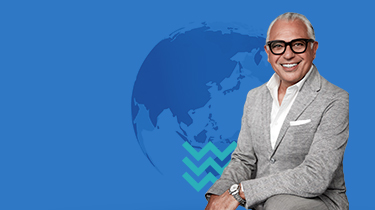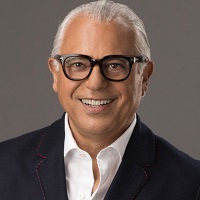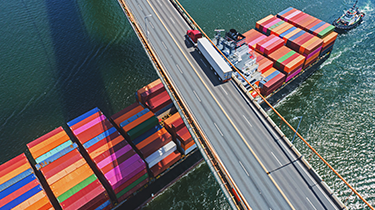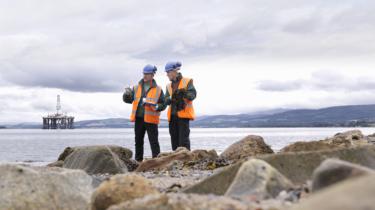
MyEDC gets you the answers you need
Join more than 30,000 Canadians who rely on MyEDC to grow their businesses with confidence.
Dec. 6, 2023

Nick (Nicholas) Chinappi from IT International Telecom sits down with our host, Joe Mimran, to talk about the exciting underwater world of fibre optic cables and communications. What emerges is an inspiring story of the company’s struggles and challenges during the COVID-19 pandemic, as well as the global opportunities that arose which helped them overcome these challenges to continue to grow their business with confidence.
Where to listen
Follow us on your favourite streaming platforms to never miss an episode of the Export Impact Podcast. Tune into our podcast for new episodes every second Wednesday at 6 a.m. ET.
Joe Mimran (00:03): Hi, welcome back to the Export Impact Podcast. It's easy to forget that we’re all connected by a network of more than a million kilometres of cable, laying on the ocean floor. These cables transmit vast amounts of data at about one-third of the speed of light and depending on where you are, those systems might be the reason you’re hearing my voice right now.
My next guest knows a thing or two about submarine internet cable. Nicholas Chinnappi is the director of Contracts and Risk Management at IT International Telecom, one of only a dozen or so companies in the world offering this kind of service. Their work spans nearly 30 years and has reached more than 65 countries.
I’d like to begin today’s episode by acknowledging that we’re recording from my office in Toronto, which is on the traditional unceded territory of many nations, including the Mississaugas of the Credit, the Anishnabeg, the Chippewa, the Haudenosaunee, and the Wendat peoples, and is now home to many diverse First Nations, Inuit and Metis people. We value taking this moment to deepen the appreciation of our Indigenous communities wherever we are, and to remind ourselves of our shared debt to Canada’s First Peoples.
Welcome to the show, Nick. Just before we dive in, no pun intended, I want to understand exactly what IT International Telecom does—laying cables underwater sounds like no easy feat.
Nicholas Chinnappi (01:35): Sure thing. IT International Telecom was founded in 1995 and has since grown to owning and operating three vessels spanning from 115 meters in length—which is more or less equivalent to the length of a football field—to our smallest vessel, which is 72 meters in length. These vessels are equipped with highly specialized equipment, which lay and repair sub-C fibre-optic networks. As you mentioned, Joe, these networks are responsible for between 98-99% of all global internet and communications traffic.
Somewhat of a miss is that most communications go about via satellite, which isn’t true. Most pass through fibre networks, some of which we install underneath the ocean. A bit more about it is we’re located here in Pointe Claire in Montreal. We also have an eastern and western coast presence in Halifax on the East Coast, which is our marine facility of excellence, and we have a presence in BC, as well. We trade internationally and our corporate international headquarters is in Barbados.
Joe Mimran (02:52): Oh, I see, Barbados. That’s fantastic. And tell me now, you’ve been in business since 1995. How long have you been with the company?
Nicholas Chinnappi (03:01): I’ve been with IT now for seven years.
Joe Mimran (03:04): Seven years. So, how was the company founded? How do you start a business like, I’m going to start laying cable on an ocean floor? What is the genesis of that?
Nicholas Chinnappi (03:14): Two of the three founders of the company still work here today and are very heavily involved in the day-to-day operations. In fact, it’s a spinoff from Teleglobe, which was a telecommunications operator and they spun that off and founded IT International Telecom. They started building and operating cable landing stations, which are at the terminal ends on land, more on the construction side, and then they pivoted to the sub-sea world of laying and installing these fibre-optic systems underwater.
Joe Mimran (03:48): Wow. And with the terrain being so wild—I mean, some of the depths that you’re dealing with are pretty incredible—I would imagine these ships that you have, these 350-foot vessels must be quite complicated pieces of equipment.
Nicholas Chinnappi (04:03): Indeed, they’re highly specialized. The equipment that’s on them is very unique. I would say in the world, there are about 50 to 60 vessels that serve the global community in installing and repairing these cables. Some systems, depending on how they’re engineered, either the cables are laid directly on the sea floor or buried with a large plow into the sea floor at full ocean depth. If the waters are 8,000 meters in depth, then the cables sit on the bottom at that depth; there’s no real constraint. The cable itself needs to be manufactured in a specific type of way for certain waters, but that being said, they typically go as deep as the ocean floor.
Joe Mimran (04:49): Incredible. And that’s not all the company does, right? I understand the company’s also involved in desktop study and marine surveys, etc. Tell us a little bit about that.
Nicholas Chinnappi (05:00): IT is a full turnkey provider in these systems, meaning we provide to our customers the entire package, which starts from, as you mentioned, the desktop study phase. Desktop study, essentially, is as the name suggests: A study that’s done at a desktop level, which comprises of research across various fields, like the ocean and environment, animal habitats, geology, so on and so forth.
Coupled with that is we send some of our specialists to site to determine where’s the best location for these cables to land on shore. If you think of a typical landing on a beach somewhere, after the desktop study, the outcome or the output of that study is a preliminary route. If you think of connecting two points across the body of water, the desktop study will outline how that cable is routed through the water and informs the length and the type of armour that’s required on the cable, depending on what the study reveals.
After that phase is the marine survey, which essentially requires the deployment of a specialized survey vessel, which serves to confirm or finalize the route that was developed in the desktop study phase. You can imagine a vessel that’s deployed that collects sub-sea data, informs the composition of the seabed using various equipment and technologies. As the vessel maps the floor, you have a better idea of exactly how the cable needs to be engineered, after which, once you have a final engineered length or cable, you could then place an order with a manufacturer. We don’t manufacture cable in-house, we outsource it to various vendors and they fabricate the cable for us. The final stage is the installation and the commissioning of the network.
Joe Mimran (07:01): Amazing. It sounds like a very complicated process. How many employees does the company have?
Nicholas Chinnappi (07:06): Our company has grown. We’re about 200 employees now, including our offshore fleet. So, spread between our office locations and on our ships, we’re more or less 200, give or take. We’ll upsize based on certain contracts that we have that are more labour intensive, but more or less 200.
Joe Mimran (07:27): You said that there are 50 or 60 vessels in the world that do the kind of work that you do. Are there Canadian competitors that you have or are you alone in the Canadian market?
Nicholas Chinnappi (07:39): We’re generally alone in the Canadian marketplace that does the type of work that we do at the level that we do. There are smaller players, but they don’t have the type of assets or capabilities and ships that we possess. So, in that sense, when you’re talking about large infrastructure projects, we basically dominate the Canadian space.
Joe Mimran (08:01): Wow. And what’s COVID-19 been like for the business? Have you had challenges during the COVID-19 period? What transpired during that and how did it affect you?
Nicholas Chinnappi (08:11): COVID was a bit of a double-edged sword for the business in that it presented very difficult challenges, but it also presented opportunities indirectly. I'll start with the challenges during a project with between 60, 70, up to 80 crew members and these crew members work on rotations. You can imagine, for example, shifts consisting of four weeks on, four weeks off; six weeks on, six weeks off, depending on the role and the type of work that’s required. During the height of the pandemic, certain countries—Canada being one of them—basically grounded airplanes to international travel. Some ports were also closed to people disembarking for vessels, you may recall with cruise ships.
A very vivid memory is when we did a large project in Chile in South America where some of our crew members were out at sea for weeks at a time. They were unable to fly back home to Canada and to their respective homes because the ports in Chile didn’t allow them to disembark, which meant we had to sail the vessel with all the crew members. So, instead of hopping on the flight for 12 hours, for example, and returning home, they had to stay on the ship for an additional 20 or 30 days—however long it took for the vessel to sail back home. And in that, the company, from a corporate perspective, you incur more costs in doing so.
It was challenging for our crew members physically, as well. There’s a familial aspect, as well, which presented its unique challenges and for the business, we always had to find creative ways of how to enter-exit different countries, regions, ports, airports. At one point, it was daily meetings in our boardroom on how we were going to implement these systems, which in themselves are very important for people because it allows them to communicate.
And then I can speak to the opportunity that presented: Even before COVID-19, a lot of countries around the world had mandates to connect all of their people by certain timelines. Canada, for example, their goal is by 2030 all Canadians will be connected to the internet. That was a goal pre-pandemic. And what the pandemic did was accelerate those goals. We’ve seen by various countries and institutions and even from private markets, a large deployment of capital towards new investment, new infrastructure, new communication systems, just because of all of the work from home: Telemedicine, tele-education, and really the explosion of data and the consumption of the data. It was very challenging and I’m glad those days are behind us from a logistics and management perspective.
Joe Mimran (11:10): It must have been very difficult on the crew to have to stay those extra days and be away from their families, and must have been a very difficult time for them.
Nicholas Chinnappi (11:20): Sure was. And that wasn’t unique to us. All seafarers around the world, who helped keep the world moving and moving cargo and all the goods that we procure and buy and consume, all the food that we consume, as well. It was a global challenge I’m sure, to other companies, like us, and the rest of the markets.
Joe Mimran (11:39): And there were also supply chain issues. Did you have supply chain issues, as well, in terms of getting cable materials produced and manufactured?
Nicholas Chinnappi (11:49): We did on various fronts. The commodities market was shaken quite a bit. Lead times of months became several months. Lead times doubled. And we have a backstop for implementation of our projects, so we saw schedule compression. Also, the labour markets were challenging, as well. The labour market remains tight; supply of spare pieces of equipment and parts. Just because these vessels are so specialized, most parts aren’t available in North America and we really need to rely on the European markets for specialized parts and spares. And that posed a very great challenge. The mere fact that they were either not obtainable or the lead times were doubled and tripled, that also had an impact.
As well, these vessels consume a lot of fuel. If we had fixed contracts on one side and fuel costs rise, we saw margin compression, as well. It was very challenging and fuel remains a challenge because prices at the pump are still high.
Joe Mimran (12:56): That’s amazing. Now, this is a company that goes back to 1995. It’s never easy to export from Canada, certainly back in '95, I think, much more challenging than today where communication is so simple. Tell us how many countries you’re in. What was the first overseas project that got the company in that mode of exporting and being a global player?
Nicholas Chinnappi (13:21): I need to be honest, Joe, I don’t know where the company worked its first project globally, but I do know most of our business is global. On the export side, most of our revenues are generated outside of Canada. The industry is global in nature. As companies develop these systems, tenders are requests for proposals are launched to the global market. We're really not confined to Canada in that sense. And if we only relied on Canada, we wouldn’t exist today. The export market is huge for us. We’ve worked in 65 to 70 different countries just in the last year or so. We’ve worked in the United States, in various states in Columbia, Chile, Guyana in the Caribbean; we worked in the U.K., France, Morocco—good geographical mix in our portfolio.
Joe Mimran (14:14): What are the challenges in dealing with so many different countries—some of the business risks, legal issues, regulatory issues—how do you manage all of that?
Nicholas Chinnappi (14:26): We try to get ahead of that at the front end. When we’re in the bidding phase of our projects, we perform an internal risk assessment. We look at various risks across different geographies. For example, if we’re bidding for work in Country X, we’ll analyze the political situation or political stability of that country. Anywhere you work in the world now, permits are required. There are evaluations and assessments on the permitting front. What’s required for our vessels to clear into specific countries.
Certain countries have specific requirements. We may need to rely on our insurance partners to buy certain insurance products. We may need to alter our port calls to ensure we comply with local rules and regulations. We do so internally and also, we engage local agents who can advise us on what’s required in terms of customs clearances and customs formalities. There’s a whole body of work that occurs at the front end and then during the management phase and implementation phase of the project, a lot of things to keep on top of.
Joe Mimran (15:37): It’s actually pretty similar to the surveys that you do in the ocean. You’ve got to do the same sort of surveys as you go into each of these countries, right? To make sure you don’t go offside. You must have quite the contacts in many of these countries. Is it something that’s very specific to your industry? Is there like a world of lawyers and consultants who work in your industry in each of these countries that you tap into?
Nicholas Chinnappi (16:03): There are very specific legal counsel in various countries who are experts, as you pointed out, in their respective fields. For example, the United States has their own set of carbon tax rules as to what’s allowed, what isn’t allowed, what will work in the U.S. waters, what custom clearance entails. There are a specific set of lawyers who specialize in advising foreign-flagged ships to enter and clear customs, exactly to your point. We have a network of partners that’s knowledgeable in those specific fields that without, we’d be walking in blind basically because there are no two countries that are alike, not only culturally, but also from the authority perspective. What’s permissible, what’s not permissible and what’s really required to clear it.
Joe Mimran (16:54): Is the business as complicated as it sounds?
Nicholas Chinnappi (16:57): It’s very niche and complicated I would say. It would be very difficult for someone to come in here and let’s say there would be an outside investor and they would want to purchase the company. They wouldn’t really be able to without retaining any type of local knowledge. It’s so specific and niche and I came from the life insurance space before I joined here and I knew little to nothing about this space and the learning curve was very steep. It’s quite challenging, but that’s what keeps it interesting.
Joe Mimran (17:29): It sounds extremely interesting, all the different countries and so many different issues that you’re dealing with, such a unique service that you provide. Are there any programs or services that you rely on to maintain competitiveness on the global stage?
Nicholas Chinnappi (17:45): There are and EDC is a valuable partner in that regard. As one example, they provide us with several products which help us not only compete but give us, I would say, financial security with regards to, for example, credit insurance or accounts receivable insurance. Basically, guaranteeing that our receivables will be honoured, guarantees all letters of credits that are issued by our banks. They back that up, so our banks feel more comfortable in issuing guarantees to our customers, which are requirements in tender or in request for proposals.
They allow us to comply with the requirements of these documents and if we wouldn’t comply, we wouldn't have the opportunity to compete and win the work. And financing facilities that EDC offers: What that does from a practical sense is it allows us to take on a bit more in bidding on contracts and undertake the work which we may otherwise not bid on, if not for the insurance blanket or safety net. And risk equals growth and if you don’t take the risk, you’ll stay stagnant and you’ll fall out of bounds.
Joe Mimran (19:01): I would think that’s quite an advantage having EDC in your corner and providing all of those different financing options. And it would probably be very difficult to get a bank to support that kind of risk because they’re so risk averse. But I think that’s what’s so great about it is that it allows you to grow internationally, be in all these countries and bring all of that great revenue back into Canada, which is what we all want.
I just want to switch gears a little bit. Everybody is so concerned about global warming, the environment, and everything that’s going on with that, and I think all companies today have to take that into account. I would think that with the amount of work that you’re doing in the oceans and everybody being so concerned about that, I would love to know how you’re managing that, what the company’s goals are, and the challenges in trying to manage all of these expectations and whether or not governments are putting extra pressure on you in the way you conduct business with the SG being such a buzz acronym right now.
Nicholas Chinnappi (20:10): From an environmental perspective, no project can proceed without permits. So that's, as a rule of thumb, these cables cannot be laid anywhere in the world. In Canada, for example, at the very infancy of any type of project, there are assessments that are done, whether they’re environmental or otherwise and the process is quite elaborate. The various authorities are engaged in issuing these permits. So, for any work in Canada, as part of the permit and principle that’s required to deploy these sub-sea systems, an authorization is required from Environment Canada. So, due diligence is done in that regard.
Permits are also required from the Department of Fisheries and Oceans (DFO) that’s responsible for ocean and marine life. They assess the impact of the project and then they determine whether or not it respects the environment and wildlife. They also, as a condition to issuing those permits, may enforce attenuation measures that we take on to ensure that the impact to the environment and to the wildlife is kept at a minimum. That’s unique to Canada when it comes to DFO, but I would say as the world evolves, more and more countries have similar infrastructure at the government level that ensures oversight and ensures that contractors as ourselves comply with regulations.
Joe Mimran (21:46): I can just imagine. Now, I understand you’re doing a project in the Arctic and that must be pretty interesting because you’ve got a compressed amount of time to work up there. Not only do you have the normal challenges, but you’ve also got this additional challenge of having to do the work in a compressed amount of time. You must put a lot of good planning into that, in order to be able to complete that work accordingly.
Nicholas Chinnappi (22:10): That’s right. The window of operability is very small, so we’re talking anywhere between two to four months, depending on the year. Some winters are worse than others. I would say planning for any type of project from start to finish takes about two years. But working in the Arctic where resources are limited, access to industrialized ports are at a great distance, it’s prudent to plan a year in advance.
Joe Mimran (22:43): That’s really quite interesting. Now, with respect to the amount of competition you have, you said that there are 60 vessels around the world. How do you see growth in light of that competition? Where do you think growth is going to come from? You mentioned satellites. That was a really interesting statistic that I wasn’t aware of. I was one of the uninformed that thought that a lot of our communication came from satellites. I knew that they laid a lot of cable during the gold rush of the internet in the late '90s, early 2000s, but I did think that it was supplanted by satellites. But that’s so interesting that it’s, what’d you say 90%? Was it 90%, 95%?
Nicholas Chinnappi (23:28): It’s 98 to 99%.
Joe Mimran (23:30): 98 to 99.
Nicholas Chinnappi (23:32): Of global communications. When you think about it, payments through banking systems, financial transactions, stock exchanges, buying and selling goods online, YouTube, Netflix, Facebook; everything is so data-intensive that the demand for more bandwidth has exploded recently. And I’ve read certain papers published online that demand will continue to grow. In terms of where do we see growth, lately, there’s been a big push, I would say in the last 10 years, for the big internet giants around the world to own and operate their own systems, namely, you know, Facebook, Amazon, Google, Microsoft. They’re deploying their own systems and they’re diversifying away from utilizing the big carriers, the big telecom operators. They have their own fibres and their own networks, so there’s growth in major data hubs around the world. Think of the New Yorks of the world, Londons, Tokyos. They will continue to prosper.
But where we see growth, at least in the Canadian market and also abroad, is as more governments push as a mandate to connect all of their citizens, that will really trigger an explosion of new systems, new investment, new development. Right now, we see a lot of growth in the Arctic and really any underserved community that’s not served by the internet right now, we believe eventually they’ll be served one day.
Joe Mimran (25:11): Amazing. Well, one of the things I think about is with all that cable at the bottom of the ocean, what happens when you get something happening and their cable breaks down or there’s some natural catastrophe that causes a cable to get damaged? Is there internet of things that sort of tied into all these cables that automatically tell you where the break is and how you can get to it, so it can get repaired?
Nicholas Chinnappi (25:37): Well, we also repair cable systems. As soon as there’s a cable break, you can measure exactly where the break occurs, and once there’s a break, we provide maintenance service for our customers, as well. Once their systems break, they advise us of the locational breaks and we use our vessels to go repair the cables. The frequency and severity of storms have increased in recent years; they cause cable systems to break. There’s more Maritime activity in general, so more vessel traffic. You know, a lot of causes of these cable breaks are from fishermen dragging their anchors and fishing equipment. Also, vessels that are dragging their anchors.
As global warming increases and weather patterns become more and more severe, there are more breaks to these cables. As there’s more international trade and marine traffic, the frequency of breaks increases, as well. And on the supply side, there’s more and more development. What we’re seeing is more cables being implemented and more breaks as well, which keeps the global fleet of 50 to 60 vessels quite active.
Joe Mimran (26:51): Just amazing. I really enjoyed this. It’s a fascinating conversation, a view into an industry that I didn’t know very much about. I'm sure people who are listening are going to very much enjoy learning about this business and really how technical it is and how diverse it is, and how many different disciplines one has to have, in order to be able to succeed in this type of industry. Kudos to you. Kudos to your team. You’ve done an amazing job. Very proud that you’re a Canadian company and doing such great work in so many different countries. Nick, thank you so much for joining me today. Really appreciate it.
Nicholas Chinnappi (27:30): Thanks for having me, Joe.
Joe Mimran (27:32): Thanks for joining us today on the Export Impact Podcast. If you enjoyed today’s episode, we’d love for you to subscribe, rate, and leave us a review on your favourite streaming platform. See you back here in two weeks.
Outro (27:47): This podcast is for information purposes only and doesn’t constitute any form of advice or recommendation whatsoever; whether accounting, financial, investment, legal, tax, or other personal, commercial, or professional advice. EDC hasn’t independently verified any of the information communicated herein and makes no representation, warranty, or guarantee, whatsoever, express or implied about the content, which shouldn’t be relied on in any way by anyone for any purpose whatsoever. EDC accepts no responsibility and will have no liability whatsoever for any damages or other losses suffered as a result of this information, its use or reliance thereon by anyone, and EDC has no obligation to update or correct any of the content.
This podcast isn’t a substitute for due diligence, and the audience should seek their own independent professional advice in respect to the contents of this podcast or any other related matter. In addition, this podcast shouldn’t be construed in any way as an endorsement or a recommendation by EDC or any form of promotion offered to sell or recommendation of any company, product, or service. While the host and or guests are customers of EDC, the views expressed herein aren’t those of EDC, its directors, officers, employees, affiliates, or subsidiaries.

Guest
Director, Contracts & Risk Management, IT International Telecom

Host
CEO of Joseph Mimran & Associates Inc., founder of Club Monaco & Joe Fresh, and former Dragon on CBC’s Dragons’ Den

Join more than 30,000 Canadians who rely on MyEDC to grow their businesses with confidence.

Understanding global economic conditions is key to making better decisions for your business.

Let us work with your financial institution to help you get the financing you need.